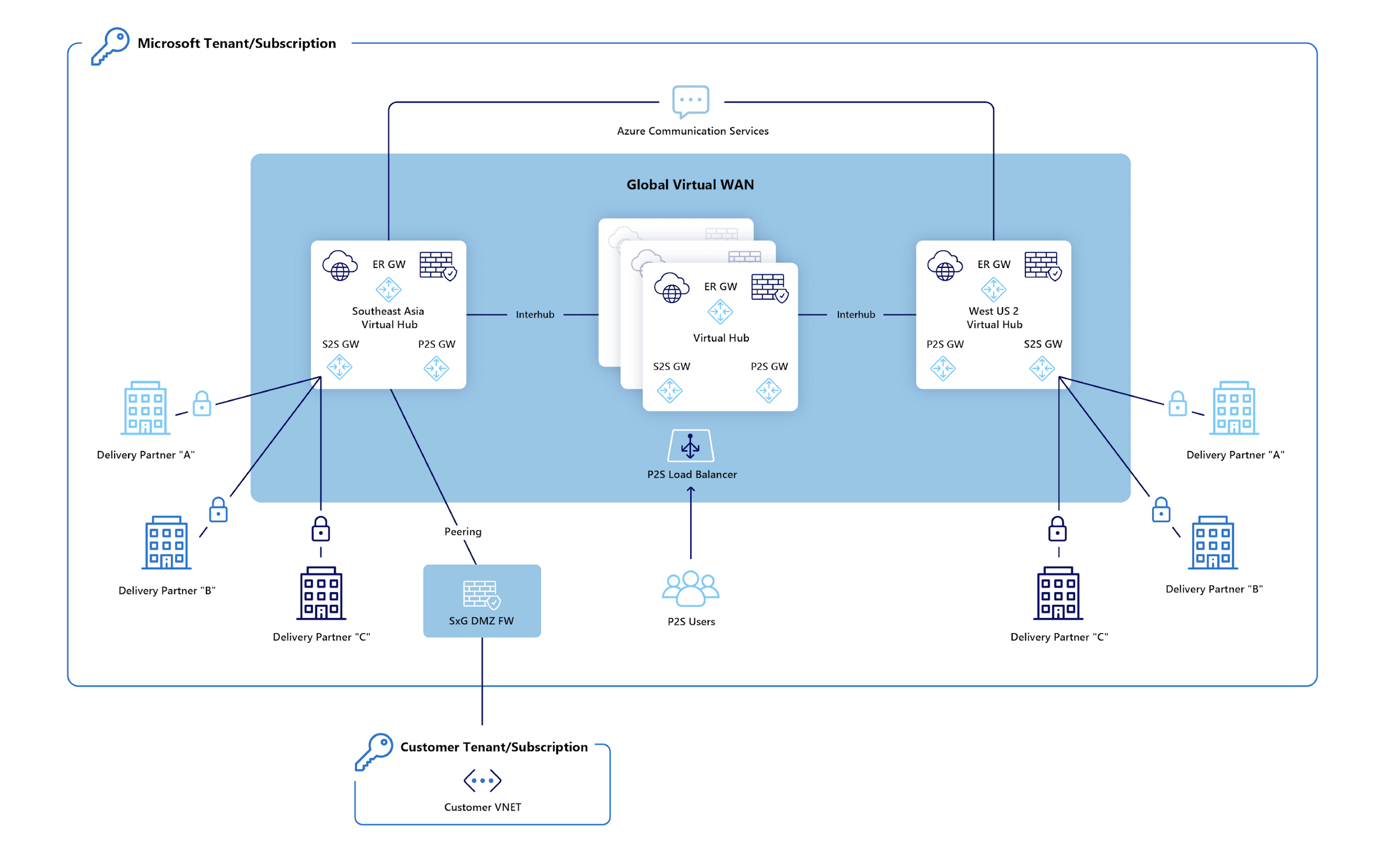
This story reflects updated guidance from Microsoft Digital—it was first published in July 2024.
Providing exemplary support is critical to how we empower our customers to achieve more with Microsoft technologies and services.
We in Microsoft Digital, the company’s IT organization, recently migrated our global Microsoft customer service network to Microsoft Azure, creating a cloud network-based solution to connect our customers to the support services they need at Microsoft. With the new solution, our customers and customer service team members are connected faster, more reliably, and with improved network performance while maintaining secure and compliant connections.
Building a better customer support network

Our Support Experience Group (SxG) within our Cloud + AI division is driving transformation for Microsoft Support solutions, building on Microsoft solutions and infusing cutting-edge innovation to improve customer and agent experiences across all our businesses. Our SxG team provides platforms and services to almost 80,000 Microsoft support advocates, including technical teams and customer support advocates from our network of global contact centers.
Our customer support advocates and partners are integral to maintaining high-quality customer service and support for Microsoft products and solutions. Microsoft customer services handle almost 200,000 support calls daily in 37 different languages worldwide. It’s a diverse and fast-paced environment where connecting support staff to the customer and the Microsoft services they support can be complex.
Our previous global network backbone served us for years through the deployment of key regional central hub sites. Hub sites were connected by physical point-to-point Multiprotocol Label Switching (MPLS) circuits deployed strategically to various sites globally. The MPLS network design is complex, costly, and inflexible.
By redesigning our network with Microsoft Azure Cloud Network solutions at the center, we’re addressing several challenges associated with traditional MPLS networks, such as:
- Cost and complexity: MPLS networks are often expensive and complex to deploy.
- Inflexibility: MPLS is designed for stable, point-to-point connections and can be too rigid for the dynamic and distributed nature of modern cloud computing. It struggles to efficiently handle the traffic patterns created by enterprises running workloads across multiple clouds.
- Deployment speed: Setting up or modifying MPLS connections can take weeks or even months, which is not conducive to the agility required by businesses today. Cloud networks can be deployed and scaled much more rapidly.
- Security and encryption: Traditional MPLS doesn’t offer encryption, which is increasingly important as operations move toward the cloud. A cloud network can provide consistent protection regardless of how users connect.
At the core of our transformation is a newly designed global, cloud-based network built on Azure Virtual WAN services called the SxG Cloud Network, built specifically for Microsoft customer services. The SxG Cloud Network directly connects advocates at Microsoft contact centers, remote advocates and internal support teams to the required services.
The SxG Cloud Network provides a highly reliable and high-performing network path into Azure, where support team members can access the tools and environments required to support our customers fully. Within the network, our customer service teams are connected to Azure Virtual Desktops that supply the tools and connectivity they need for troubleshooting, enabling them to connect with Microsoft customers worldwide through virtual private network (VPN) and Azure Virtual Network (VNet) peering.
The SxG Cloud Network resides on the Microsoft Azure tenant and consists of several virtual WAN hubs in key Azure regions across the globe. These hubs use Microsoft Azure Firewall to secure traffic flows within the cloud network using URL filtering, TLS inspection, and intrusion detection and prevention.
The Azure-based hubs provide a single access point that simplifies connectivity and creates a unified and consistent environment for all support advocates. We provide several connectivity methods for our Microsoft customer support advocates irrespective of location, including:
- Point-to-site (P2S) VPN: This provides connectivity for the remote user working from home.
- Site-to-site (S2S) VPN: We use S2S VPN to connect Microsoft contact centers using an S2S encrypted tunnel between the partner VPN concentrator and the SxG Cloud Network gateway.
- VNet peering: We also support peering between a partner Azure tenant and the SxG Cloud Network Azure tenant. VNets on both tenants are directly peered and secured by Azure Firewall.
Point-to-site VPN
Remote Microsoft customer support advocates use Azure P2S VPN to connect directly to Microsoft services in Azure. We maintain several VPN hubs across global Azure regions to ensure that advocates experience the most direct network path to Azure. We use Azure networking components within Azure to connect to the required internal Azure resources.
To ensure that only necessary traffic goes through the VPN, VPN profiles are configured with split-tunnel routing that routes Microsoft specific traffic to Azure and the rest to the partner network or the public internet. This ensures that users can access local websites in the correct locale and languages they need, while also enabling low-latency access to the Microsoft corporate edge network.
The Azure VPN client facilitates connectivity between the local device and the Azure Virtual WAN gateway hosted in the SxG network. We use a single VPN profile configured with split tunneling for all VPN users. This is made possible by a key feature of Azure Virtual WAN that automatically connects P2S users directly to the closest region. Authentication is required to access the VPN and users authenticate using their Microsoft credentials through Entra ID and multi-factor authentication.
Site-to-site VPN
S2S VPN connections provide a secure encrypted VPN connection over the public internet to connect our contact centers to Microsoft customer support services in Azure. The contact center partner manages their network and the configuration of the device on their network, which establishes a VPN tunnel to the Azure Virtual WAN gateway hosted in the SxG Cloud Network.
VNet peering
When partners already have an Azure presence, Microsoft can connect the partner Azure network to the virtual WAN using Azure VNet peering. Traffic between the peered VNets doesn’t leave the global Azure backbone network. We use SxG VNet peering to connect VNets in the Microsoft tenant with VNets in the partner’s Azure tenant. VNet peering establishes a high-performance, trusted connection using Azure Firewall in the SxG Cloud Network to provide flow control and traffic protection.
SxG Cloud Network infrastructure

Managing connectivity for voice services
Our advocates often support our customers with voice calls, and supporting an effective and efficient voice service is integral to the SxG Cloud Network.
We use Azure ExpressRoute connections to create a direct private network path from all our Azure Virtual WAN gateways to our voice services platform environment using an MPLS backbone. These global connections to our voice services hosted in Azure enable advocates connected to the SxG Cloud Network via P2S, S2S, or VNet peering to use our voice services. The Interhub feature in Azure Virtual WAN also provides seamless connectivity between hubs, ensuring that user network traffic takes the best path with minimal latency while traversing the Microsoft backbone network.
Microsoft customer service advocates voice services are now migrated to Azure Communication Services, which is connected to the SxG Cloud Network with ExpressRoute and keeps traffic on the reliable Azure backbone network.
The SxG Cloud Network has modernized how we connect to voice and data services hosted in Azure and can provide advocates access without needing to deploy physical circuits to contact center locations, saving time and money. It also creates a unified network environment, simplifying access points and functionality for our advocates.
With the flexibility and scalability of the SxG Cloud Network, we can manage our bandwidth needs better and have fewer physical circuits that are oversized for the traffic volume. This alone is reducing network costs by more than 60% in specific cases. While exact figures for cost savings and performance improvements can vary depending on the specific circumstances of a deployment, businesses often report significant reductions in total cost of ownership (TCO) and enhancements in network performance when migrating from MPLS to Azure cloud-based solutions.
Looking forward
As we look to the immediate future of the SxG Cloud Network, we’re excited about increasing Azure Communication Services traffic on our network for voice support, further unifying our services and leading to more significant cost savings and efficiency. We’ll continue searching for ways to improve the SxG Cloud Network, including moving the network edge closer to our users with new global virtual WAN hubs. This helps us deliver more effective and easy-to-use support services for Microsoft customers and the advocates who support them.

We’re benefiting from the SxG Cloud Network in several areas, including:
- Experience enhanced support: Connect faster and more reliably to support services thanks to our migration to the Azure-based SxG Cloud Network, ensuring high-quality assistance whenever Microsoft customers need it.
- Global reach, local service: The SxG Cloud Network spans countries and languages, providing a seamless support experience through a diverse team of professionals ready to assist customers.
- Secure and simplified connectivity: Azure Virtual WAN offers various connection options, including VPN and VNet, to ensure a secure, direct connection to support resources.
- Future-ready voice services: Azure Communication Services is creating a more integrated and cost-effective voice support system, enhancing the support experience while maintaining the highest network reliability standards.








